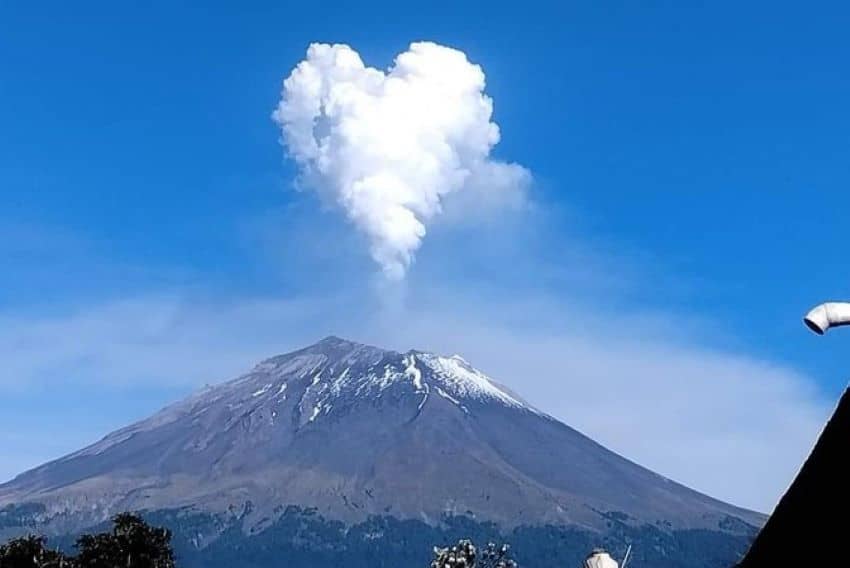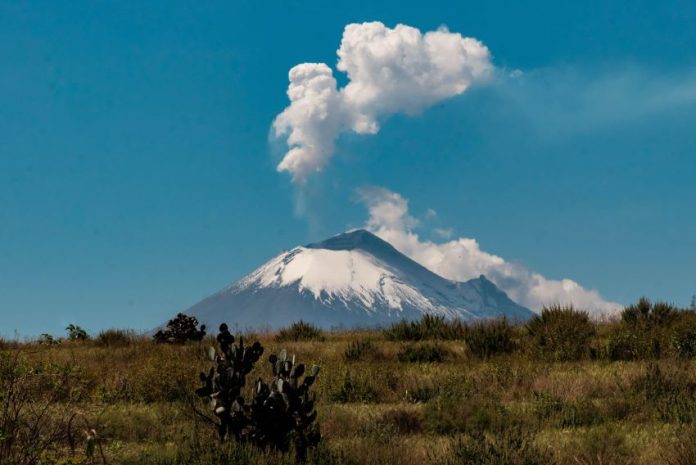Mexico’s Popocatépetl volcano has been active this week, prompting advisories from Civil Protection authorities and forcing the Puebla International Airport to suspend operations Friday morning.
The National Disaster Prevention Center (Cenapred) reported 45 exhalations since Oct. 15. As of Thursday morning, the volcano recorded over 1,000 minutes of tremors during the previous 24-hour period.

The activity of Don Goyo, as the volcano is known, prompted México state authorities to make arrangements to evacuate nine municipalities should the eruptions become more intense, according to the newspaper El Sol de México. Although the increased activity has nearby communities on alert, one pyroclastic cloud this week prompted observers to recall the famous Mexica legend of Prince Popocatépetl and the nearby Iztaccíihuatl volcano, which means “sleeping woman”, in Nahuatl. (Popocatépetl means simply “smoking mountain.”)
A unique heart-shaped fumarole
On Wednesday afternoon, Popocatépetl emitted a huge fumarole that split in the middle, eventually taking the shape of a giant heart as it rose into the sky.
Social media erupted with comments that “romance was in the air” and that “Popo” was sending love letters to his beloved Iztaccíhuatl.
According to Mexica Aztec legend, the princess Iztaccíhuatl was in love with Popocatépetl, one of her father’s warriors. The emperor sent Popocatépetl to war, promising him Iztaccíhuatl as his wife when he returned (though presuming he would die in battle).

Iztaccíhuatl was falsely told Popocatépetl had been killed and, believing the news, she died of grief. When Popocatépetl returned to find his love dead, he took her body to a spot outside Tenochtitlan (now Mexico City) and kneeled by her grave. The gods covered them with snow and transformed them into great mountains. According to the legend, that was how Popocatépetl became a raging volcano, raining fire on Earth in blind fury at the loss of his beloved.
Popocatépetl, one of the world’s most dangerous volcanoes
Popo, a 17,694-foot-high volcano, is 70 kilometers (43 miles) southeast of Mexico City. Prevailing winds typically direct ash clouds to the east toward Puebla state. Friday’s volcanic activity forced the cancellation of several flights at Puebla City’s airport.
The National Meteorological Service issued a report on Friday morning that visibility was sufficient to track Popocatépetl’s activity. and Meanwhile, Cenapred maintained its 24-hour Volcanic Alert Signal at Yellow 2, meaning eruptions and emission of ash, gas and water vapor are possible.
The institution warned civilians to stay away from the mountain, since incandescent fragments could be hurled from the crater and advised residents of the region to pay heed to messages from local Civil Protection authorities.
With reports from Milenio, El Sol de México, Uno TV and Infobae
